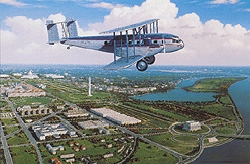|
|
| Flying Luxury Liner |
|
 |

|
 |
|
|
| DESCRIPTION |
 |
| 16 x 11.5 Inch Collector Size Unframed Lithograph $40.00
The Curtiss Condor was the civilian transport version of the B-2 bomber. It was developed in the late 1920s with the principal design staff consisting of G. Page, T. Wright, S. Vaughn, and R. Beisel. The design utilized the same metal tube and aluminum spars as in the B-2. The Condor was wider with a six foot wide fuselage, and as there was no need for gunner cockpits, the aft engine nacelles were faired in and the space utilized for mail and cargo. A significant design factor was the incorporation of 3 inches of “Dry Zero” soundproofing in the cabin, which made the Condor considerably quieter inside than the other passenger craft of the era. The interior of the Condor was quite spacious and luxurious with a full six feet eight inches of head room in the cabin. The Condor was arranged to carry 18 passengers with six seats arranged in three cabins. Reclining seats were utilized in the two forward cabins with the rear cabin equipped with lounge seats. Passengers had large windows for site-seeing, and passenger lighting and air vents were utilized. The Condor also had a heated cabin, not common on most aircraft of that era, which was driven by two small boilers attached to the engine exhaust manifolds. A lavatory with hot and cold running water was also standard. The Condor first flew in July of 1929. Early production models were difficult to fly and the Curtiss Company undertook modifications to improve the flying characteristics of the aircraft. With the Great Depression underway it was not easy getting orders for this aircraft, and Eastern Air Transport ended up as the proud owner of six Condors. The Curtiss Company opted to kill the Condor program at this point and focus on a totally new aircraft, the T-32 Condor II. The Condors went on to serve Eastern well. The aircraft was reasonably reliable and was well liked by passengers. Glenn H. Curtiss made his final flight in May of 1930 in a Condor from Albany to New York, which was to commemorate his historic flight of twenty years earlier. Two months later, Curtiss, one of the early pioneers of American aviation would die at age fifty-two. In Stan Stokes painting, entitled Flying Luxury Liner, an Eastern Air Transport Condor approaches Hoover Field in Washington, D.C. in November of 1931. The T-32 Condor II’s debut was impacted by the introduction of the Douglas DC-1 in 1934. This all metal, low wing monoplane would become the DC-2 in its first production variant. The days of the passenger biplane, for al practical purposes, were over. |
|


|